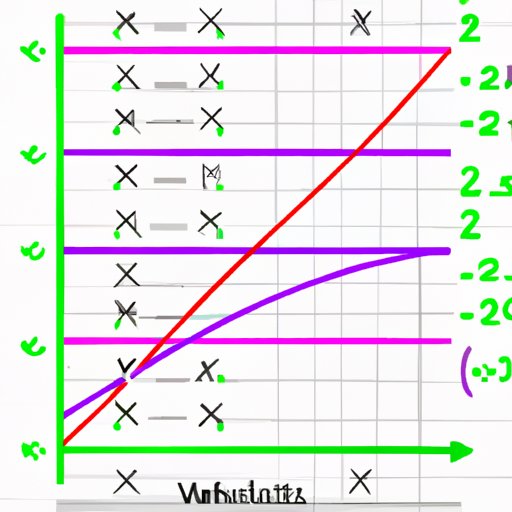Introduction
Inequalities are a crucial part of mathematics that describe relationships between values that are not equal. They provide useful information in many real-life scenarios and are essential to problem-solving. Understanding how to solve inequalities accurately and efficiently is therefore critical.
A Step-by-Step Guide on How to Solve Linear Inequalities
Linear inequalities are inequalities where the expressions on both sides of the inequality sign are linear functions. Here are the steps for solving them:
1. Isolate the variable
Begin by isolating the variable on one side of the inequality sign. This step is similar to solving an equation.
2. Determine the direction of the inequality by dividing/multiplying both sides by negative/positive numbers
To ensure the inequality holds, you might need to multiply or divide both sides of the inequality by a positive or negative number. Remember to change the direction of the inequality if you multiply or divide by a negative number.
3. Write the solution set in interval notation
Once you have solved for the variable, write the solution set in interval notation. For example, if the solution is all values greater than or equal to 5, write [5, ∞).
Example: Solve for x in the inequality 2x + 8 ≤ 6x – 4.
2x + 8 ≤ 6x – 4 Subtract 2x from both sides
8 ≤ 4x – 4 Add 4 to both sides
12 ≤ 4x Divide by 4
3 ≤ x Write the solution set in interval notation
[3, ∞)
The Importance of Understanding Inequalities in Mathematics
Inequalities have many real-world applications in fields like business, finance, and science. They are used to set budgets, determine investment opportunities, and estimate scientific calculations. Inequalities are also closely related to equations. Solving an equation means determining the exact value of a variable, while solving an inequality means identifying a range of values that satisfy the inequality.
Example: A company wants to produce no less than 400 and no more than 600 products per month. If the company produces x products per month, write and solve an inequality that represents the company’s production target.
400 ≤ x ≤ 600 Write the solution set in interval notation
[400, 600]
Solving Inequalities with Absolute Values
Absolute values provide an additional layer of complexity when solving inequalities. The expression within the absolute value can be either positive or negative, so it is necessary to solve for both possibilities. Here are the steps:
1. Isolate the absolute value expression
First, isolate the absolute value expression on one side of the inequality.
2. Split into two separate inequalities (one positive, one negative)
Next, split the inequality expression into two separate inequalities by considering the absolute value as either positive or negative.
3. Solve for each inequality separately
Solve each inequality separately. Remember to change the direction of the inequality if you multiply or divide by a negative number.
Example: Solve for x in the inequality |3x + 2| > 5
3x + 2 > 5 or 3x + 2 < -5 Solve for both inequalities 3x > 3 or 3x < -7 x > 1 or x < -7/3 Write the solution set in interval notation (-∞, -7/3) U (1, ∞)
Using Graphing Techniques to Solve Inequalities
Graphing inequalities can be a useful way to visualize the solution set of an inequality. Here are the steps:
1. Convert the inequality to slope-intercept form (if necessary)
If the inequality expression is not in slope-intercept form (y = mx + b), convert it to this form.
2. Plot the y-intercept
Identify the y-intercept of the inequality expression on the vertical axis.
3. Use the slope to plot additional points
Use the slope of the inequality expression to plot additional points on the graph.
4. Draw the line and determine the appropriate shading
Draw a solid line if the inequality expression includes either “<=" or ">=”, and draw a dashed line if the inequality expression includes “<" or ">“. Determine the appropriate shading by testing a point within each region.
Example: Solve for y in the inequality 2y + x < 5 y < (-x/2) + (5/2) Plot the y-intercept and use the slope to plot additional points Draw a dashed line and test a point within each region to determine the appropriate shading.
Solving Systems of Inequalities
Systems of inequalities are inequalities with multiple expressions. The solution to a system of inequalities is the overlapping region on a coordinate plane. Here are the steps for solving them:
1. Graph each inequality on the same coordinate plane
Use graphing techniques to plot each inequality on the same coordinate plane.
2. Identify the overlapping region
Identify the overlapping region on the coordinate plane. This region will be the solution set of the system of inequalities.
Example: Solve the system of inequalities
x + y ≥ 5
x – y > 1
Graph each inequality on the same coordinate plane and identify the overlapping region.
Common Mistakes to Avoid When Solving Inequalities
Common mistakes when solving inequalities include forgetting to change the direction of the inequality when multiplying or dividing by a negative number, combining terms that cannot be combined, and incorrect graphing. To avoid these mistakes, carefully follow the steps outlined in this guide, and double-check your work to ensure that you have solved the inequality correctly.
Conclusion
Solving inequalities is a crucial skill for success in mathematics and many real-life scenarios. By following the steps outlined in this guide, you can accurately and efficiently solve linear inequalities, inequalities with absolute values, graph inequalities, and solve systems of inequalities. Practice is key to building proficiency, so keep practicing and refining your problem-solving skills.
